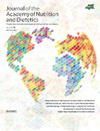德克萨斯州休斯顿少数种族和族裔青少年通过反射光谱法测量的皮肤类胡萝卜素与蔬菜摄入频率相关。
IF 4
2区 医学
Q2 NUTRITION & DIETETICS
Journal of the Academy of Nutrition and Dietetics
Pub Date : 2024-11-17
DOI:10.1016/j.jand.2024.11.010
引用次数: 0
摘要
背景:需要客观的方法来评估青少年的水果和蔬菜摄入量,以便更好地评估旨在改善水果和蔬菜摄入量的干预措施。皮肤类胡萝卜素浓度测量为果蔬摄入量提供了一个潜在的客观生物标志物,但其合理性和稳健性必须在青少年群体中得到证实:本研究旨在评估德克萨斯州休斯敦市美国少数种族青少年中,通过压力介导反射光谱法测量的皮肤类胡萝卜素得分(SCS)与自我报告的类胡萝卜素摄入频率之间的关系:这是对参与随机对照研究 "青少年通过活动、人际关系和良好饮食(Take CHARGE!)参与者为西语裔(86.2%)、非裔美国人(12.6%)和亚裔(1.2%)青少年(10-17岁)(N=167),他们于2018年8月至2019年在德克萨斯州休斯顿参加了为期一年的健康生活方式计划,作为他们的体育课:在一年的时间里,通过压力介导反射光谱法测量参与者的SCS,并在四个不同的时间点使用学校体育活动和营养问卷中的问题评估自我报告的FV摄入频率:使用广义线性混合模型检验了青少年SCS与FV摄入频率之间的关系,并控制了BMI z分数、性别、时间点、组别分配和年龄:结果:自我报告的FV摄入频率(β=2.398,p=0.028)、蔬菜(β=3.870,p=0.010)、橙色和深绿色蔬菜(β=5.274,p=0.019)对SCS呈正向预测,与水果摄入频率(β=1.151,p=0.613)无显著关系:结论:在德克萨斯州休斯顿的少数民族青少年中,自我报告的总类胡萝卜素(合计)、蔬菜、橙色和绿色蔬菜(合计)摄入频率可预测SCS。皮肤类胡萝卜素测量作为美国青少年蔬菜摄入量的生物标志物,值得进一步研究。本文章由计算机程序翻译,如有差异,请以英文原文为准。
Skin Carotenoids Measured by Reflection Spectroscopy Correlates with Vegetable Intake Frequency in Adolescents of Racial and Ethnic Minorities in Houston, Texas
Background
Objective methods are needed to assess adolescent fruit and vegetable (F/V) intake to better evaluate interventions aimed at improving F/V intake. Skin carotenoid concentration measures provide a potential objective biomarker of F/V intake, but the plausibility and robustness must be established across adolescent populations.
Objective
The objective of this study is to evaluate the relationship between pressure-mediated reflection spectroscopy-measured skin carotenoid scores (SCSs) and self-reported F/V intake frequency among US racial and ethnic minority adolescents in Houston, TX.
Design
This is a secondary analysis of data collected on adolescents participating in the randomized, controlled study Teens Committed to Health Through Activity, Relationships, and Good Eating.
Participants and setting
Participants were Hispanic (86.2%), African American (12.6%), and Asian (1.2%) adolescents (age 10 to 17 years) (N = 167) who participated in a year-long healthy lifestyles program as their physical education class in Houston, TX, from August 2018 to 2019.
Main outcome measures
Over the course of a year, participants’ SCSs were measured by pressure-mediated reflection spectroscopy, and self-reported F/V intake frequency was assessed using questions from the School Physical Activity and Nutrition questionnaire at 4 separate time points.
Statistical analysis
The relationship between adolescent SCSs and F/V intake frequency was tested using generalized linear mixed models, controlling for body mass index z score, sex, time point, group assignment, and age.
Results
SCSs were positively predicted by self-reported intake frequencies for F/V (β = 2.398; P = .028), vegetables (β = 3.870; P =.010), and orange and dark green vegetables (β = 5.274; P = .019), with no significant relationship observed with fruit intake frequency (β = 1.151; P = .613).
Conclusions
Self-reported total F/V (combined), vegetable, and orange and green vegetable (combined) intake frequency is a predictor of SCSs among racial and ethnic minority adolescents in Houston, TX. Skin carotenoid measurement merits further investigation as a biomarker of vegetable intake in US adolescents.
求助全文
通过发布文献求助,成功后即可免费获取论文全文。
去求助
来源期刊

Journal of the Academy of Nutrition and Dietetics
NUTRITION & DIETETICS-
CiteScore
7.20
自引率
10.40%
发文量
649
审稿时长
68 days
期刊介绍:
The Journal of the Academy of Nutrition and Dietetics is the premier source for the practice and science of food, nutrition, and dietetics. The monthly, peer-reviewed journal presents original articles prepared by scholars and practitioners and is the most widely read professional publication in the field. The Journal focuses on advancing professional knowledge across the range of research and practice issues such as: nutritional science, medical nutrition therapy, public health nutrition, food science and biotechnology, foodservice systems, leadership and management, and dietetics education.
 求助内容:
求助内容: 应助结果提醒方式:
应助结果提醒方式:


